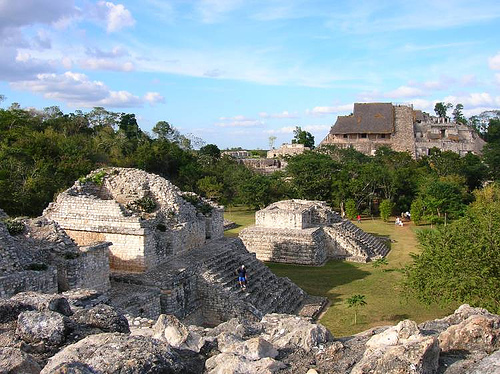

Location: 51 km (32 mi) North- East of Chichen Itza Map
Open: 8am- 5pm
Entrance Fee: USD $4
Ek Balam or "Black Jaguar" in Mayan language is a Yucatec- Maya city located just 30 km north of Valladolid in Mexico. Ek Balam achieved power and importance during Late Classical period between 600 and 900 AD when large pyramids and ceremonial structures were build here. Fertile farmlands that fed the citizens of the city went into decline with worsening climate. At the arrival of the Spanish conquistadors in the 16th century only a small fraction of the original population still lived here.
The Acropolis is the largest structure at Ek' Balam and contains the tomb of Ukit Kan Le'k Tok'. It measures 146 meters across, 55 meters wide and 29 meters tall.
The Oval Palace (Ek Balam Archaeological Site)Entrance Arch (Ek Balam Archaeological Site) |
Ball Court (Ek Balam Archaeological Site)The "Twin Pyramids" (Ek Balam Archaeological Site) |
Stella which depicts a ruler of Ek Balam, probably Ukit Jol Ahkul.
The two unexcavated structures (Structure 2 and Structure 3) which are located to the East and West of the Acropolis and are the 2nd and 3rd largest at the site.
Ek' Balam was occupied from the Middle Preclassic
through the Postclassic, although it ceased to thrive as a major
city past the Late Classic. Beginning in the Late Preclassic, the
population grew and the city expanded throughout the following
periods. It eventually became the capital of the polity that
controlled the region around the beginning of the Common Era.
At its height from 770 to 840 CE, Ek' Balam provides a rich
resource of information for understanding northern Classic cities,
due to the poor preservation of many other notable northern Maya
sites (e.g. Coba, Izamal, and Edzna). It was during this height that
the Late Yumcab ceramic complex (750-1050/1100 CE) dominated the
architecture and pottery of Ek’ Balam. The population decreased
dramatically, down to 10% of its highest, during the Postclassic
period as Ek’ Balam was slowly becoming vacant. There are several
theories to why it was eventually abandoned and to the degree of
haste at which it was abandoned.
Ek Balam is mentioned in a
late-sixteenth-century Relación Geográfica, an official inquiry held
by the colonial government among local Spanish landowners. It is
reported to have belonged to a kingdom called 'Talol', founded by an
Ek' Balam, or Coch Cal Balam, who had come from the East. Later, the
region was dominated by the aristocratic Cupul family.